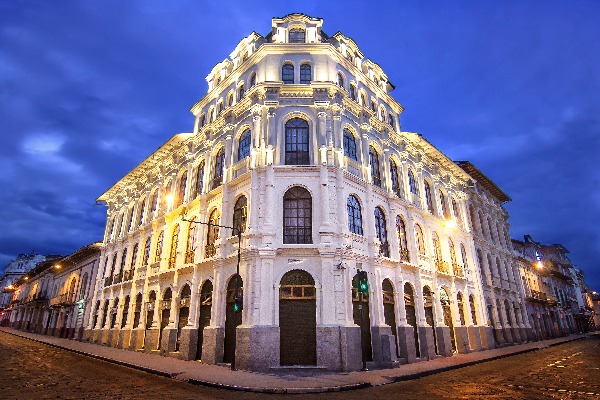Area’s worst natural disaster remembered on the 30th anniversary of the Josefina landslide and flood
By Sylvan Hardy
As they do every year, a small group will gather Wednesday on the banks of the Rio Paute, near the town of Paute, to remember those killed 30 years ago in what has become known simply as the Josefina Disaster, a giant landslide that blocked the Rio Paute. The blockage created what was, for a month, the largest lake in Ecuador, extending into the northeast suburbs of Cuenca.

Much of the town of Paute was flooded when the landslide that blocked the Rio Paute was breached in 1993.
The March 1993 landslide and subsequent flood, named for the village of Josefina, destroyed more than 1,000 homes and killed at least 100 people. The resulting flood backed up to the Cuenca suburbs of La Paz and Challuabamba, causing hundreds of millions of dollars in property damage. Before the 300 foot high landslide-dam collapsed on June 2, many thought the flood waters would inundate Cuenca itself.
Although heavy rains contributed to the landslide, authorities later concluded that it was actually triggered by illegal gravel and sand mining at the base of the mountain. The collapse dumped more than 20 million cubic meters of earth into the Rio Paute canyon that connects Cuenca to Paute and Gualaceo, killing 70 people instantly.
The landslide prompted new legislation in the Ecuadorian congress aimed at restricting and controlling mountain minding activities. For the first time, permits were required for above-ground mining in the country.
In the weeks following the landslide, the lake behind the dam grew to 15 miles in length and contained almost 300 million cubic meters of water.
Sight-seers from across Ecuador flocked to the area to witness colonial-era haciendas, along with modern subdivisions, disappear beneath rising waters. The mayor of Azogues caused a minor scandal when he went boating on the new lake and suggested to a newspaper reporter that it would make a good tourist attraction.

Flooded homes on the Paute River in 1993.
Owners of farms and holiday homes, many of them from Cuenca, agonized as they watched rising water inundate their property. Cuenca’s El Mercurio newspaper reported that some homeowners hired professional divers to recover valuables from submerged houses. According to the article, little was recovered and some accused the divers of theft.
Geologists and engineers from around the world, including a team from the U.S. Army Corps of Engineers, came to Cuenca to work with local authorities to find a solution as waters rose. Because the blockage was so large, answers were not easy to come by.
Authorities agree that things would have much worse had a channel not been cut into the dam to release some of the water as the lake grew. Evacuations of residents for almost 40 kilometers below the landslide were responsible for saving countless lives.
When the earthen dam broke on May 2, only a few dozen lives were lost although hundreds of houses, some of them dating to the 1600s, were destroyed in the flood. The Paute hydro- electric project, 30 kilometers downstream, sustained serious damage to its turbines but, because the water level in the reservoir had been drawn down, most of the project survived. The Paute plant produced 65% of Ecuador’s electricity in 1993.

Volunteers removed some of the bodies near the landslide but most were never found.
Several downstream villages were destroyed and river rose almost a 100 feet near the town of Paute, standing three feet deep in the central square. The volume of water released was so great that measuring stations on the Amazon River, a thousand miles to the east, recorded a rise in water levels after the dam collapsed.
The scouring force of the flood is still evident in the Paute Valley and work continues in many areas to remove rock and gravel from the river bed. A monument stands near the point where the landslide occurred, at the junctions of Rios Paute and Jadan.
Although experts say a recurrence of the Josefina disaster is unlikely, they urge that mountain stabilization work continue. The 10-year project that removed millions of meters of rock and gravel near the site of the disaster, concluded in 2008.
The Ecuador Ministry of Transport and Public Works and the Azuay Provincial Council agree that more should be done and they are in talks with the experts who planned the original remedial work. According to geological engineer Raúl Sarra Pistone, author of the master stabilization plan, “We have accomplished a great deal in terms of strengthening the mountain slope. On the other hand we need to do more to make sure we never have another disaster like this one.”





















